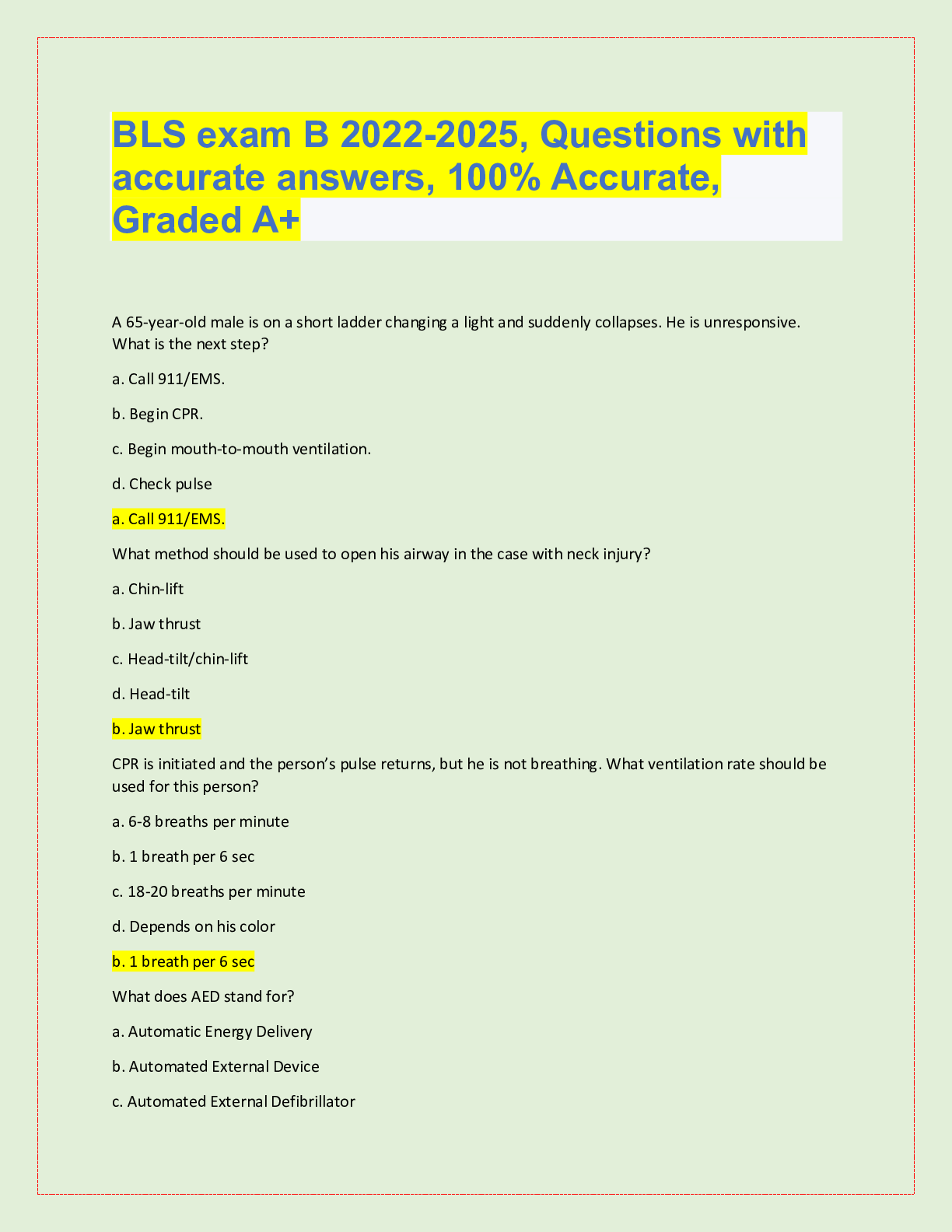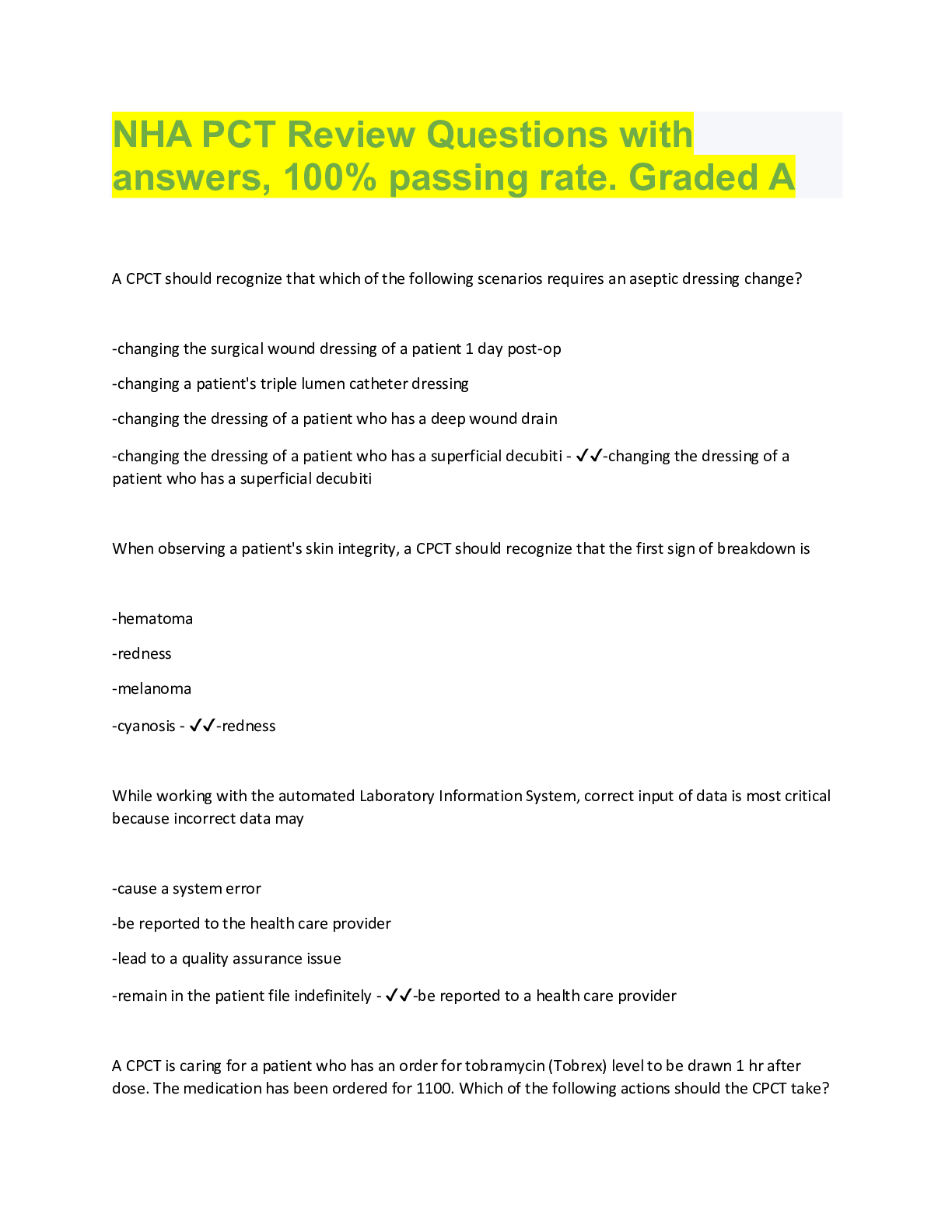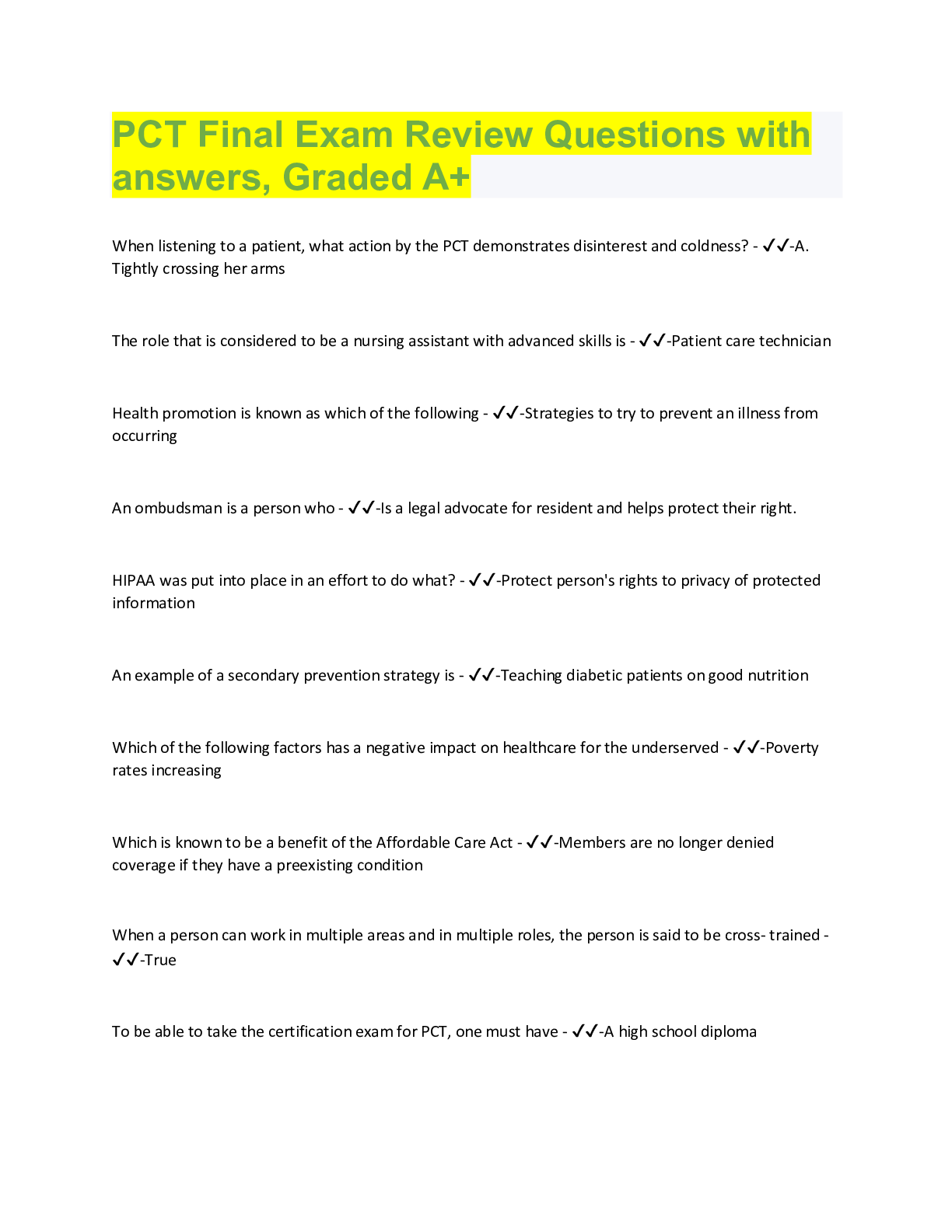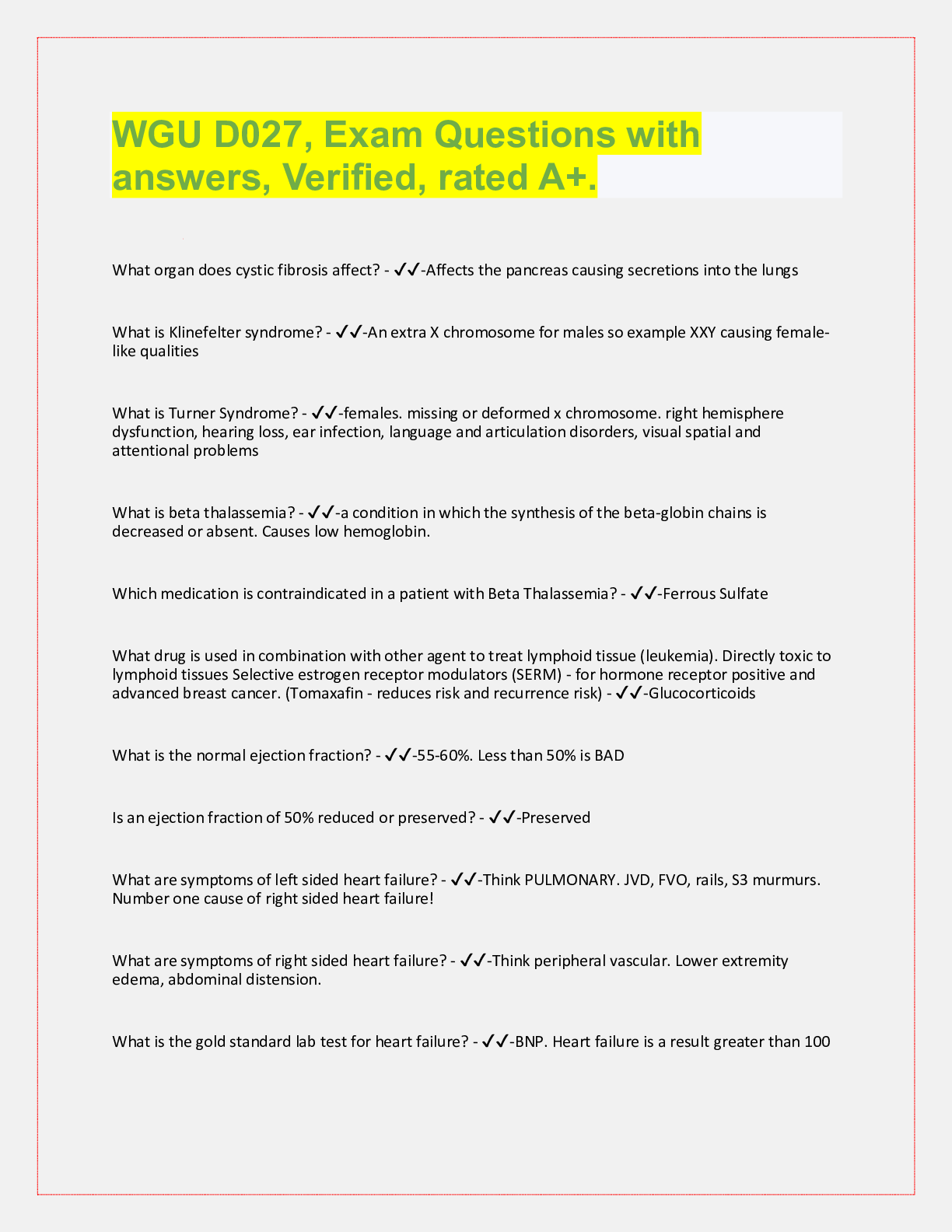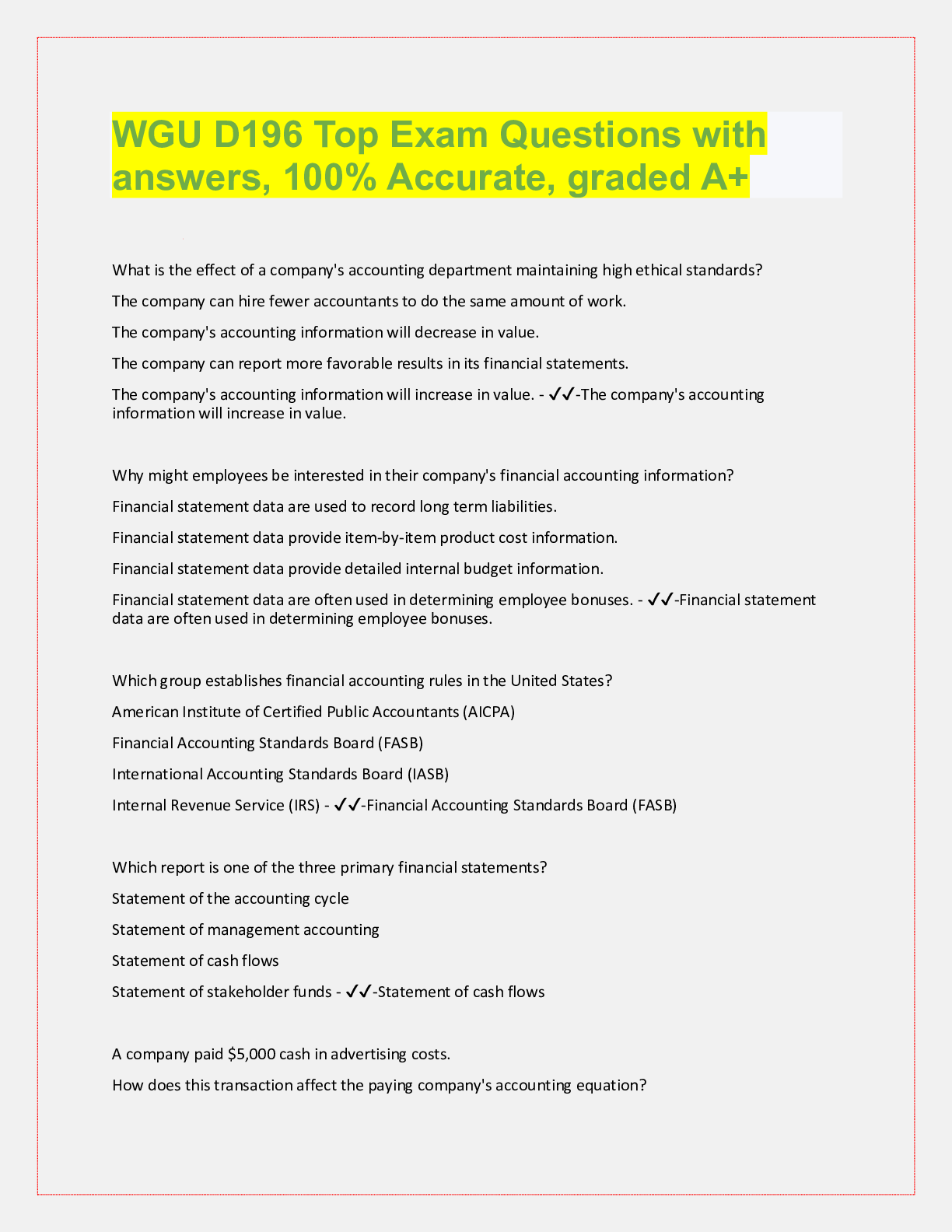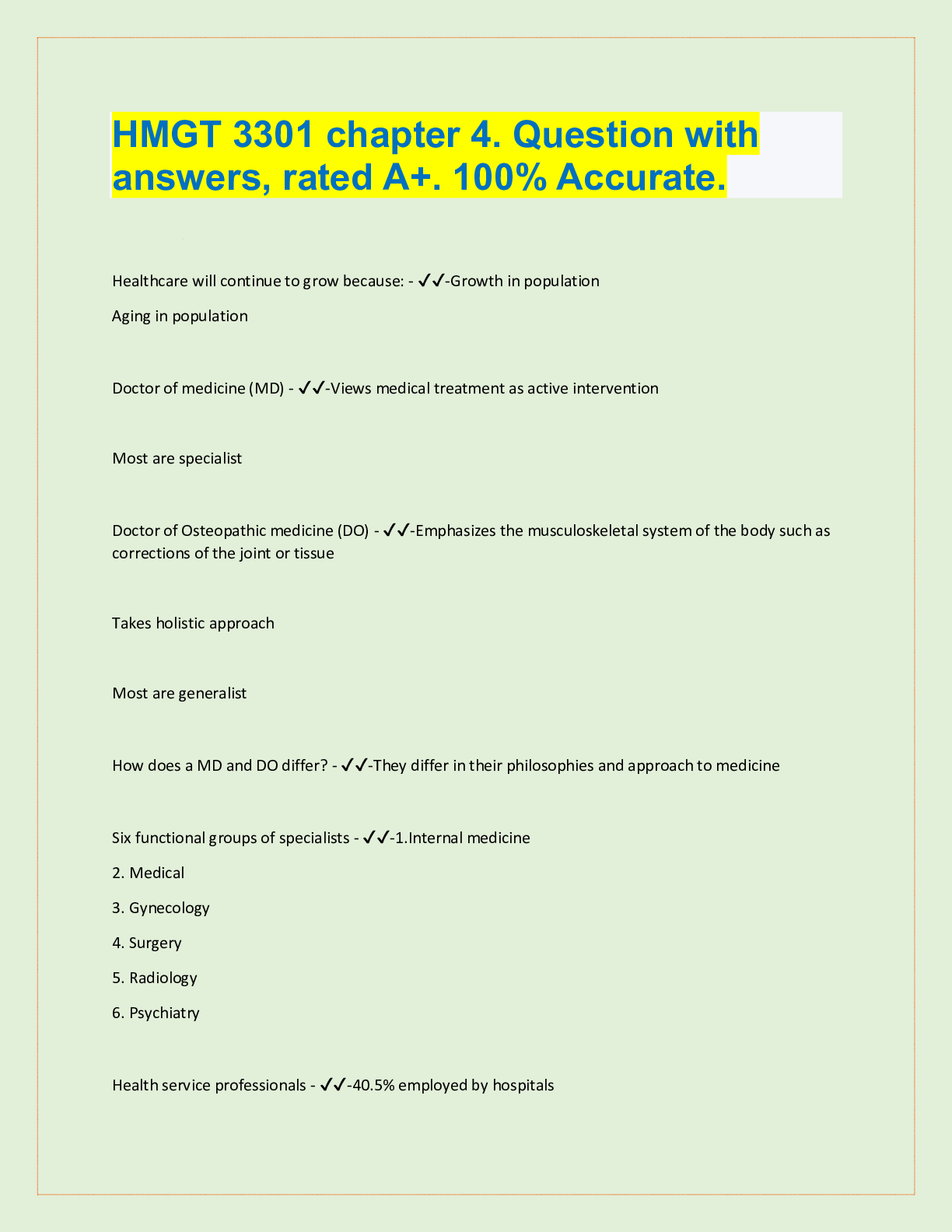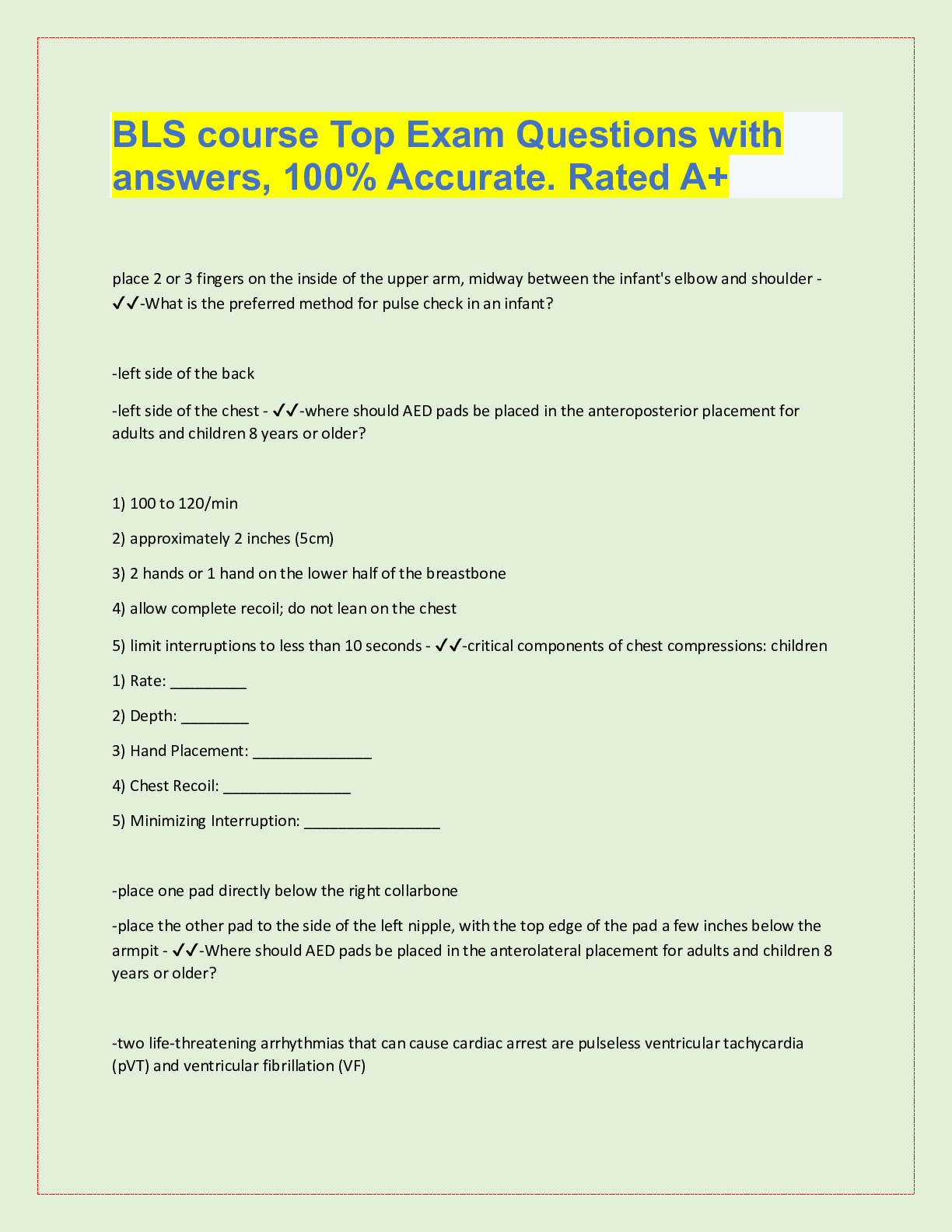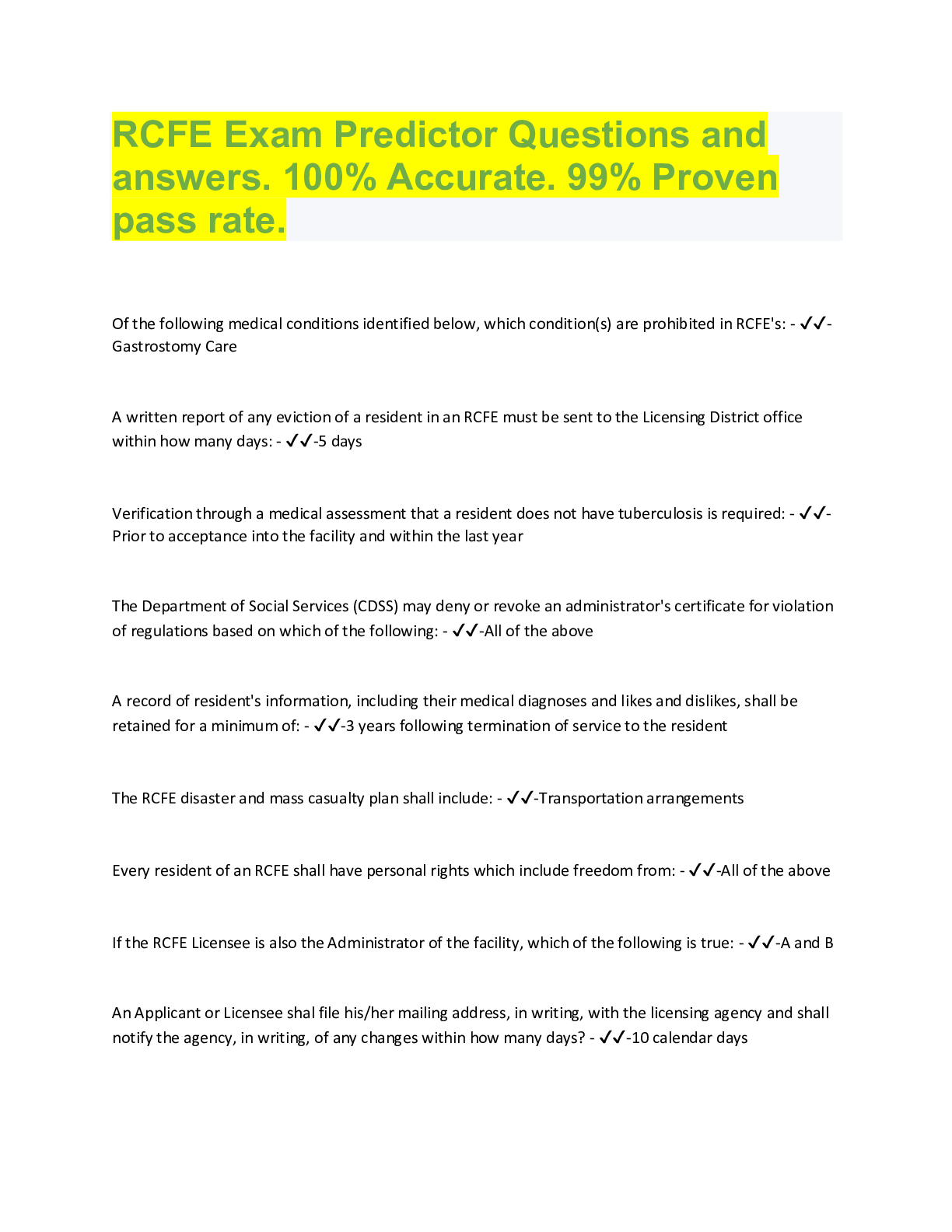*NURSING > QUESTIONS & ANSWERS > HBS Final Exam Review! Questions with answers, Verified revision. 100% Proven pass rate (All)
HBS Final Exam Review! Questions with answers, Verified revision. 100% Proven pass rate
Document Content and Description Below
HBS Final Exam Review! Questions with answers, Verified revision. 100% Proven pass rate. Anterior - ✔✔-Situated toward the front of the body Deep - ✔✔-Away from the body surface, more in... ternal Directional terms - ✔✔-Terms used to explain where one body structure is related to another Distal - ✔✔-Situated from the point of attachment or origin or a center point; located away from the center of the body. Dorsal - ✔✔-Being or located near,or on,or toward the back, or posterior part of the human body. Inferior - ✔✔-Situated below and closer to the feet than another and especially another similar part of an upright body especially of a human being. BELOW Lateral - ✔✔-Of or relating to the side; especially of a body part. Medial - ✔✔-Lying or extending in the middle; especially of a body part. Posterior - ✔✔-Situated at or toward back part of the body. Proximal - ✔✔-Situated next to or near the point of attachment or origin or center point. Superficial - ✔✔-Of, relating to, or located near the surface. Superior - ✔✔-Situated toward the head and further away from the feet than another and especially another similar part of an upright body especially of a human being. ABOVE System - ✔✔-A group of body of organs or structures that together perform one or more vital functions. Ventral - ✔✔-Pertaining to the anterior pr front side of the body; opposite or dorsal. ATP - ✔✔-An adenine-containing nucleoside triphosphate that releases free energy when it's phosphate bonds are hydrolyzed. This energy is used to drive endergonic reactions in the cell Basal metabolic rate (BMR) - ✔✔-The rate at which heat is given off by an organism at complete rest Body mass index (BMI) - ✔✔-A measure of body fat that is the ratio of the weight of the body in kilograms to the square of its height in meters Digestion - ✔✔-The process of making food absorbable mechanically and enzymatically breaking it down into simpler chemical compounds in the alimentary canal Digestive system - ✔✔-The bodily system concerned with the ingestion, digestion, and absorption of food. Enzyme - ✔✔-A protein serving as a catalyst, a chemical agent that changes the rate of reaction without being consumed by the reaction. Esophagus - ✔✔-A muscular tube that in adult humans is about nine inches long and passes from the pharynx down the neck between the trachea and spinal column and behind the left bronchus where it pierces the diaphragm slightly to the left of the middle kind and joins the cardiac end of the stomach Gallblader - ✔✔-a membranous sac in which bile from the liver is stored Gastrointestinal Tract - ✔✔-The stomach and intestine as a functional unit Large intestine - ✔✔-The more terminal division of the vertebrate intestine that is wider and shorter than the small intestine, typically divided into cecum, colon, and rectum and concerned especially with the resorption of water and the formation of feces Liver - ✔✔-The largest internal organ in the vertebrate body; performs diverse functions such as producing bile, preparing nitrogenous wastes for disposal and detoxifying poisonous chemicals in the blood Oral Cavity - ✔✔-The part of the mouth behind the gums and teeth that is bounded above by the hard and soft palates and below by the tongue and by the mucous membrane connecting it with the inner part of the mandible Pancreas - ✔✔-A gland with dual functions: the non-endocrine portion secretes digestive enzymes and an alkaline solution into the small intestine via a duct; the endocrine portion secretes the hormone insulin and glucagon into the blood. Peristalsis - ✔✔-Successive muscular contractions along the wall of a hollow muscular structure. Pharynx - ✔✔-An area in the vertebrate throat where food and air passage cross. Salivary amylase - ✔✔-A salivary gland enzyme that digest starch and carbohydrates. Salivary gland. - ✔✔-Exocrine glands associated with the oral cavity. The secretions of salivary glands contain substances to lubricate food, adhere together chewed pieces into a bolus, and begin the process of chemical digestion. Small intestine. - ✔✔-The part of the intestine that lies between the stomach and the colon, consist of duodenum, jejunum, and ileum, secretes digestive enzymes, and is the chief site of the absorption of digested nutrients. Stomach - ✔✔-A saclike expansion of the alimentary canal of a vertebrate communicating anteriorly with the esophagus and posteriorly with the duodenum and being typical a simple often curved sac with an outer serious coat, a strong complex muscular wall that contracts rhythmically, and a mucous lining membrane that contains gastric glands. Adipose tissue - ✔✔-Connective tissue in which fat is stored and which has the cells distended by droplets of fat. Appendicular skeleton - ✔✔-Bones of the limb girdles that are attached to the axial skeleton. Connective tissue - ✔✔-Animal tissue that functions mainly to bind and support other tissue, having a sparse population of cells scattered through an extracellular matrix. Axial skeleton - ✔✔-The skeleton of the trunk and head Epithelial tissue - ✔✔-Sheets of tightly packed cells that line organs and body cavities. Femur - ✔✔-The proximal bone of the hind or lower limb that is the longest and the largest bone in the human body, extends from the hip to the knee. Humerus - ✔✔-The longest bone in the upper arm or forelimb extending from the shoulder, to the elbow. Brain Stem - ✔✔-The part of the brain composed of the midbrain, pons, and medulla oblongata and connecting the spinal cord with the forebrain and cerebrum Cerebellum - ✔✔-dorsally projecting part of the brain concerned with the coordination of muscles and maintenance of bodily equilibrium, situated between the brain stem and the back of the cerebrum Dendrite - ✔✔-Any of the usually branching protoplasmic processes that conducts impulses towards the body of a neuron. Neuron - ✔✔-A nerve cell; the fundamental unit of the nervous system, having structure and properties that allow it to conduct signals by taking advantage of the electrical charge across its cell membrane. Neurotransmitter - ✔✔-A substance ( as norepinephrine or acetylcholine) that transmits nerve impulses across a synapes. Synapse - ✔✔-The place at which a nervous impulse from passing one neuron to another. Endocrine Gland - ✔✔-A gland (as the thyroid or the pituitary) that produces an secretion into the bloodstream-- called also ductless gland, gland of internal secretion Endocrine System - ✔✔-The gland and parts of the gland that produce secretions, help to integrate and control bodily metabolic activity, and include especially the pituitary, thyroid, parathyroid, adrenals, islets of Langerhans, ovaries, and testes. Glucagon - ✔✔-hormone that promotes an increase in the sugar content of the blood by increasing the rate of the breakdown of the glycogen in the liver. Hormone - ✔✔-chemical messenger Hypothalamus - ✔✔-The ventral part of the vertebrate forebrain; functions in maintaining homeostasis, especially in terms of thirst and hunger. Insulin - ✔✔-hormone that lowers blood glucose levels by promoting the uptake of glucose by most body cell and the synthesis and storage of glycogen in the liver. Pituitary Gland - ✔✔-An endocrine gland at the base of the hypothalamus; master endocrine gland Central Nervous System - ✔✔-brain and spinal cord Cerebrum - ✔✔-Large part of the brain in charge of problem solving, memory, learning, emotions, and reasoning Axon - ✔✔-the part of the neuron that leads nervous impulses away from the cell body; transmitter portion of the neuron dendrite - ✔✔-the part of the neuron that conducts impulses toward the cell body; a receiver portion of the neuron neuron - ✔✔-a functional nerve cell synapse - ✔✔-location at which a nervous impulse passes from one neuron to another; a gap between neurons cerebellum - ✔✔-part of the brain in charge of coordination and balance Peripheral Nervous System - ✔✔-Composed of the spinal and cranial nerves Occipital Lobe of the Cerebrum - ✔✔-Visual Center of the brain Temporal Lobe of the cerebrum - ✔✔-Hearing Center of the brain accommodation - ✔✔-the automatic adjustment of the eye for seeing at different distances affected mainly by changes in the lens astigmatism - ✔✔-a defect of the lens causing light rays from a point to fail to meet in a focal point resulting in a blurred and imperfect image (glasses or contacts can correct this condition) blind spot - ✔✔-small circular area where the optic nerve enters the eye that does not have any rods and cones and is insensitive to light cone - ✔✔-photoreceptors responsible for color vision cornea - ✔✔-the transparent part protective layer of the eyeball that covers the iris a [Show More]
Last updated: 2 years ago
Preview 1 out of 16 pages
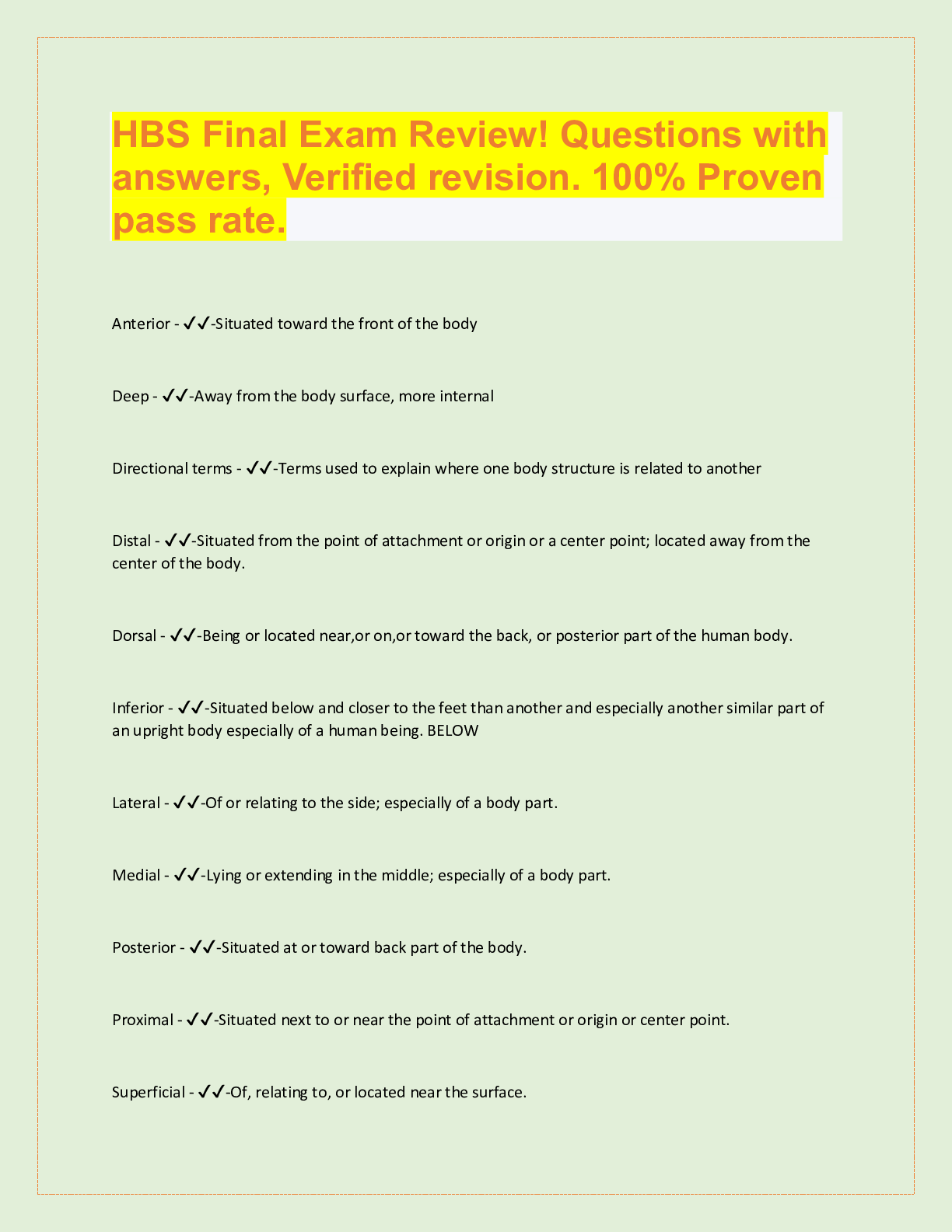
Buy this document to get the full access instantly
Instant Download Access after purchase
Buy NowInstant download
We Accept:

Also available in bundle (1)

HBS final Exam BUNDLE, QUESTIONS AND ANSWERS.
HBS final Exam Questions and answers, Latest updates, rated A+. 11 DIFFERENT EXAM VERSIONS, VERIFIED.
By Topmark 2 years ago
$30
10
Reviews( 0 )
$8.00
Can't find what you want? Try our AI powered Search
Document information
Connected school, study & course
About the document
Uploaded On
Mar 12, 2023
Number of pages
16
Written in
Additional information
This document has been written for:
Uploaded
Mar 12, 2023
Downloads
0
Views
70

